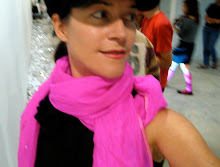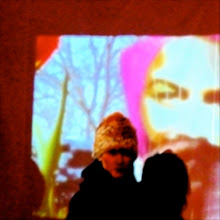So the world that I've been looking into is the immersive experience — moments of collective group joy — and from the research I've tried to glean what ingredients can be deconstructed out and used for my own live art pieces. These moments have been wide ranging, from festivals to processions, from happenings to pilgrimages. I like groups of people together doing the same thing in their own way. I like setting bodies in motion. I like to be a part of the group, and to watch the group.
I say that the stage is a concrete physical place which asks to be filled,
and to be given its own concrete language to speak. I say that this
language intended for the senses and independent of speech, has
first to satisfy the senses, that there is a poetry of the senses as there
is a poetry of language, and that this concrete physical language to
which I refer is truly theatrical only to the degree that the thoughts is
expresses are beyond the reach of the spoken language.— Artaud (1958) The Theater and its Double. p37
Naturally as a graphic designer I've had to prove that this work is within the realm of communication design. I think I have. I'll get back to that in another chapter. But for now I'd like to dwell on the idea of people as paintbrushes. On the concept of using bodies to express concepts within a time based period.
Some people use paint, I use the human body in motion to express my ideas. This started in Tokyo. as a designer promoting and branding, documenting and archiving events. For fun I threw costume parties (I'd been hosting gatherings since childhood). As the designer of an event, I controlled all aspects of the planning. The time, the location, the duration, the sequencing. I choreographed without having the performers available for rehearsal. I had to imagine and sculpt in advance — the boundaries and limits, the structure so to speak, of a thing that didn't yet exist. And the whole thing would then come to life for a brief and magical period, and then be done. This is the nature of the event. it is so very different form a performance. There are no dress rehearsals. There is no 'out there' audience (i take that back totally, the out there audience views through mediated translations. TV, web, flikr, etc). but in the moment. it is LIVE. once off. not repeatable.
I like this alchemy. Of playing with time. Of giving a space. Of structuring from nothing a group shared something. The more structured the planning, the more playful the actual experience. The limitations of location, time (sometimes of noise and number of people etc) helped to focus the events and allow for spontaneity and improvisation. The less I planned, the more open the invisible structure...often the more chaotic and less intense the experience, some spillage of energy and thinness of immersion occurred.
A theatrical piece ought to be written, presented, costumed, furnished with musical accompaniment, played and danced, by a single individual. This universal athlete does not exist. It is therefore important to replace the individual by what resembles an individual most: a friendly group.— Cocteau, Les Maries de la Tour Eiffel
These early experiments were mainly costume parties. A Chinese opera party, an Oscar Wilde Party. 50 people. set menu, three stages. we met for champagne, were paraded through the space, led to our long tables (arranged seating preplanned by me), ate, then went up to the rooftop for dancing and music.
The communion and communication and play and theatricality of the nights were etched in memories. For not only me, but for all the participants. I like this. Setting up shared moments that are tattooed in the memory. I like stopping time. I like the magic of being silly with wonderful people. It is this interest that fueled the MFA and my current research.
For the last 6 years I've been focused in this world (5 more if you count art directing for TAC and ACCJ's events). Much more conceptually than in the past. At this point I've staged over a dozen experiences and exhibited or been asked to present in the states, uk, taiwan, tokyo and sinagpore.
To link the theater to the expressive possibilities of forms, to everything in the domain of gestures, noises, colors, movements, etc., is to restore it to its original direction, to reinstate it in its religious and metaphysical aspect, is to reconcile it with the universe.What I've gleaned from the research and studies is that there are ingredients that can be used to foster the potential for synergy. Often color, movement, masks, time and place have been used. I've focused on color. By this I mean the uniforms of the participants. We share the same color. If the event is red, we all wear red. If the event is based on an object and the group is enormous, we wear black. Sameness immediately sets the groupness.— Artaud
From there I use action. More specifically, an activity. The group is tasked with either doing something, with acting out something, or with being something. This action is expressed by the group. The individuals come up with the solution. It is spontaneous and it ends. There is a limit. In time, in stage area, in a sense of completion.




No comments:
Post a Comment